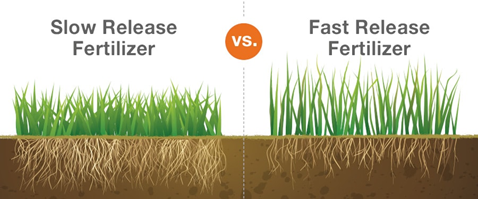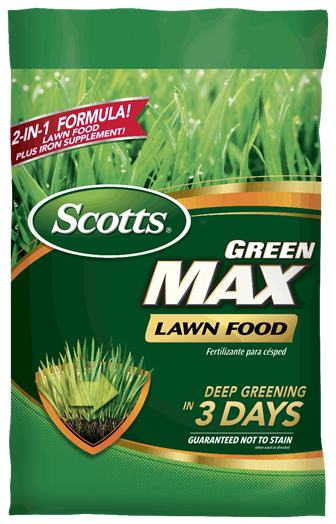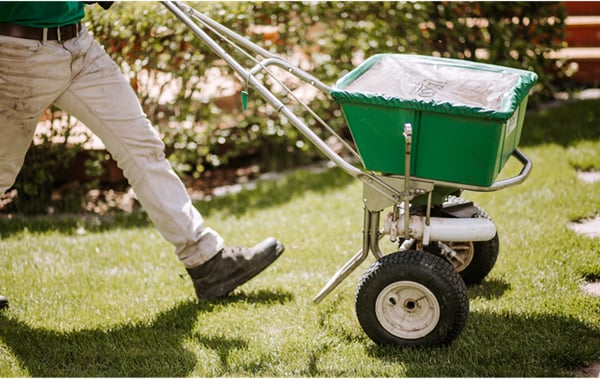Lawn Care Fertilizer: A Complete Guide
In the 16th century, lawns were first invented in Northern Europe, they were a rare sighting and only existed in private gardens as they were expensive to maintain and grow. In the 17th and 18th century, lawns were becoming more of a commodity. They were placed in more public and social areas and it was much more of a common sighting, especially across Europe and Japan.
Fast forward now to the 21st century, lawns are everywhere; parks, gardens, commercial spaces, residential lawns, farmer fields, pretty much almost everywhere you look you will see a lawn. Some fun facts about lawns:
- Per day, nearly 11% of Canadians aged 30 and over spent time working on their lawn or garden, with the average participant spending more than 2 hours doing yard work.
- The sale of lawn and garden products, equipment and plants from large retailers is over $2 billion per year
- Almost 75% of all households in Canada have a lawn and garden
- Almost half of all households in Alberta and Saskatchewan use lawn care fertilizer year to year, with Saskatoon leading the way at 57% and Edmonton trailing at 48%
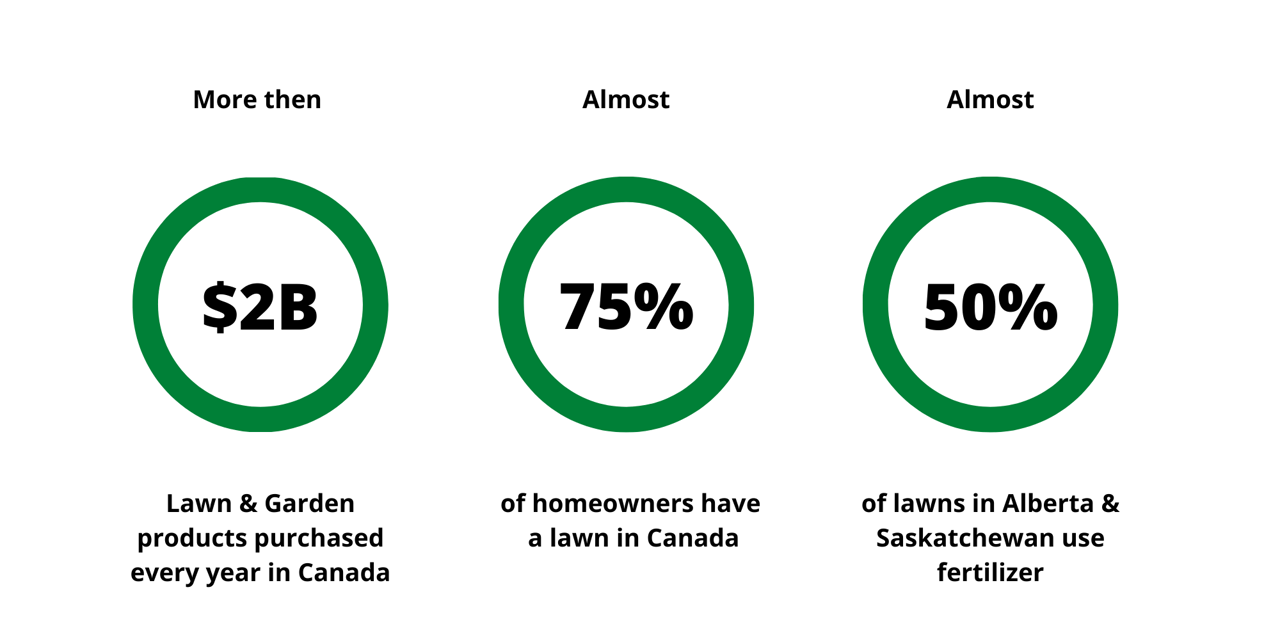
Having an amazing lawn is all about having great soil quality to support the grass growth. The main components of a healthy lawn is fertilizing year to year and understanding these 7 concepts:
- The Importance of pH Balance
- The Big 3: Nitrogen, Phosphorus and Potassium
- The Micronutrients in Fertilizer
- Importance of Having Healthy Soil
- Regular Watering Schedule
- Slow Release and Fast Release Fertilizers
- Different Ways to Apply Fertilizer
Importance of pH Balance in Your Lawn
Sounds like soil science is pretty complicated hey? Well it is, however, we will keep our guide to a basic understanding, so you as a homeowner will be able to fully understand and take away some basics and start using them on your lawn. In science, pH stands for power of hydrogen, pH below 7 are considered acidic and pH above 7 are alkaline. If you recall back in your junior high science lab, there were litmus tests conducted to see if a solution was basic or acidic. Soil is generally on the neutral side, ranging from 5.5 to 7.0 on the pH scale.
Typically, out east in Ontario, the soil is more acidic, and they require lime every season to lower the pH level. Out west, it’s the opposite, the soil here is far more basic and requires soil conditioners to lower the pH to a neutral state. The ideal pH for best results is between 6.2 and 6.5, you can find your pH by doing a soil test.
Contact us today if you would like a soil test conducted. After the soil test is conducted, if the pH is above the 6.5 mark, we have many soil conditioners and services that will help alleviate this issue. The main factor that contribute to soil acidity is rainfall, when the water mixes with carbon dioxide it forms a weak acid that will lower the pH.
Understanding The Big 3: Nitrogen, Phosphorus and Potassium
Have you ever been to a Home Depot or Lowe’s, look at a bag of fertilizer and have no idea which one to get? There are so many different options and not all are created equal. Every fertilizer bag will have three numbers on it: Nitrogen, Phosphorus & Potassium otherwise knows as NPK.
To summarize the basics, Nitrogen drives the bus and is the leading ingredient for accelerated growth. Without nitrogen, there would be zero growth as the plant absorbs more nitrogen that any other nutrient. However, using too much nitrogen can cause the lawn to burn out, especially in the summer. Don’t just buy the bag with highest nitrogen amount, make sure its in the right season and you do your soil tests before throwing down a bag of fertilizer.
Phosphorus is all about root health and root stimulation, its directly linked to the plants ability to store and use energy. Luckily in Alberta, phosphorus is readily available in the soil and usually is not a huge factor when choosing a lawn fertilizer as the lawn is not in need of it.
Potassium is the protector of the lawn. It will protect against diseases, dry summer months, root systems, and temperature variances. Potassium is an important nutrient in fertilizer that cannot be overlooked.
Time for some math! The healthy ratio for the NPK in a lawn is a 4-1-2. Meaning 4 parts nitrogen, 1 part phosphorus and 2 parts potassium for best results. When you see a fertilizer bag, it will commonly have numbers like 30-10-15, the 30, 10 and 15 represents the percentage of nitrogen, phosphorus and potassium, respectively. Now, if the bag weights 50 lbs and it covers 10,000 square feet. You will be putting down 5 pounds per 1000 square feet. Knowing that you put down 5 pounds over 1000 square feet, 30% is nitrogen, 10% is phosphorus and 15% is potassium. Therefore 1.5lbs is nitrogen, 0.5lbs is phosphorus and 0.75lbs is potassium. If you followed me to this point you are doing great!
Before you put down a significant amount of fertilizer, it is important to conduct some soil tests research beforehand. The soil tests will be able to tell you if you are missing a key macro nutrient, pH balance is off or if you are missing a micro nutrient discussed in the third section.
What Are The Importance of Micronutrients in Fertilizer?
The micronutrients are just as important as the macro nutrients, except they are required in much smaller amounts. Keep your eye on these micronutrients as they play a very important role in your lawn care fertilizer program.
After the big three macro nutrients, the most important one after that is magnesium. Magnesium is essential to turning the turf green, it plays a key role in photosynthesis in the development of chlorophyll. During extended dry periods is when magnesium is required the most. However, potassium, discussed above, excess potassium can eliminate the magnesium in the soil. Conduct a soil test to see if there is too much potassium in your soil that may be preventing the magnesium from working properly.
Iron is another very key component of a healthy lawn. Most high-quality fertilizers will have at least 1 or 2% iron in it. Having iron is one of the best ways to get your lawn to have a nice dark green color to it without excessive growth and increased risk of diseases. If the lawn lacks iron, you will notice a yellow discoloration that’s known as chlorosis where the lawn doesn’t produce enough chlorophyll to turn green. In Alberta, since most lawns have a higher pH and have wet conditions especially through spring will yield an iron deficiency. Make sure to aerate year to year at minimum to avoid iron deficiency in your lawn.
Manganese is another major component and helps the plant take in more nitrogen and completes the photosynthesis process. Typically, a manganese deficiency will occur in younger plants and freshly planted sod. They are common with lawns with sandy soil and with pH levels over 7.
Copper is mainly influenced by the soil pH of the lawn and the organic content of the soil. If the pH is too high or too low, copper will be deficient in the soil and promote poor growth. You can notice a copper deficiency by looking at the tips of the lawn, if its looks grey or blue that could be a result of not enough copper in the lawn. Before adding copper to your lawn, always conduct a soil test prior, you can add copper through synthetic or organic fertilizers. The typical rate is at 0.1 pounds per 1000 square feet for copper either through foliar spray or spreading it.
Sulfur is likely the least important micronutrient, its also the least likely your lawn will be deficient in it. Sulfur is need for the plant to produce nitrogen, and it plays a role in the formation of proteins. In rainy areas, such in Alberta in the springtime, there is enough sulfur in to ensure that there are no deficiencies in the soil.
How Important Is It To Have Healthy Soil Beneath The Lawn?
It's the most important part, healthy soil will make healthy grass. To be clear, when we were talking about pH balance, macronutrients and micronutrients above, we are always referring to the soil measurements. People tend to get confused and think we are doing a measurement of Nitrogen in a blade of grass, that is not the case. We are always conducting soil tests, as healthy soil will make sure your lawn is extremely healthy. Unfortunately, here in Alberta, most homes come with less then ideal soil quality. Good news is that with soil conditioners, whether you have clay or sandy based soils, the products at Yard Dawgs can be a turning point for getting the best soil quality.
The four main functions of having a healthy soil is:
- as a source for plant growth
- as a means of water storage, supply and purification
- as a modifier of the Earth’s atmosphere
- as a habitat for organisms
Soil conditioners have three key ways to improve the soil:
1. Soil Structure
Soils over time can become extremely compacted, from foot traffic, heavy snow falls and running the lawn mowing over it year after year. When the soil is compacted, that is a breeding ground for weeds and other lawn diseases. Soil amendments can help break apart the soil and make it less compacted.
2. Soil Nutrients
As discussed in the above sections, soil amendments may contain compost, macro and micronutrients to help promote a healthy lawn. This will enrich the soil, allowing the lawn grow extremely well.
3. Water Retention
They can help with water retention as well, especially is dry and coarse soils. Its important for the soil to hold water to help grow a healthy lawn. If the water just drains right through the soil, it will be short on nutrients.
Physical Properties Of Soil Textures
The particles that make up soil are categorized into three parts: sand, silt and clay. The relative percentage of these three parts is what determines the soil type. See the figure below to see the twelve different types of soils. Knowing the type of texture will help us know what soil is best used to grow a healthy lawn. The three best soil types for homeowners’ lawns are circled in green below.
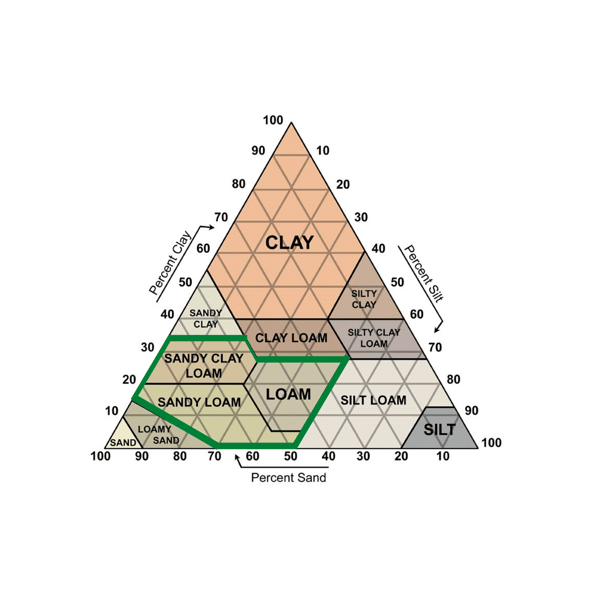 While the professionals use a hydrometer to measure soil structure. For us homeowners, there are some DIY ways of accurately predicting your soil structure. Here are the three best tips to help determine the soil structure of your lawn:
While the professionals use a hydrometer to measure soil structure. For us homeowners, there are some DIY ways of accurately predicting your soil structure. Here are the three best tips to help determine the soil structure of your lawn:
1. Watch what happens after a heavy rainfall!
Does the water drain internally through your lawn and there is hardly any water on the surface of the turf? Then you have a sandy soil and not much clay content. If the water rests on the surface of the lawn, then the soil has a lot of clay content.
The study done by Thriving Yard states that for any puddles of water that form on your lawn (meaning clay soil), the best solution is to aerate and to follow is concept of deep soil integration that he mentions.
2. Get that garden shovel out!
This is the ultimate DIY trick; get the shovel out and get a soil sample that is 3-5 inches below the grass. Take the sample and feel it in your palm. If it feels similar very rough and gritty, then you have very sandy loam. If it feels very soft, almost like flour, then the soil has lots of silt. If it feels sticky, then the soil has a lot of clay content. Before doing the palm test, add some water to the soil sample so its moist, make sure its not overly wet or dry. For a more detailed technique, checkout Page 11 of the study done by Purdue University.
3. Leave it to the experts!
Sometimes its best to just have the experts tell you what you have. There are some soil tests that you can buy on Amazon. The other option is to take a soil sample, and send it off to a lab and have them do it for you. They typically cost anywhere between $50-$100 depending on the level of detail you want.
Fertilizer Watering Schedules
Fertilizer should be watered in after application. It doesn’t need to be immediately right after but should be within 24 hours post-application. Just a light watering is all that’s needed, just to wash the coating off so that the NPK ingredients can be absorbed into the soil. Don’t overwater the lawn, or else the fertilizer can wash off the lawn and onto the streets and sidewalks which is not good for the environment.
If there is rain in the forecast, that’s even better and just let mother nature do the work. On average in Calgary, your lawn needs one inch of water per week. The best way to measure that is not through measuring how much time you’ve watered, as all flow rates are different depending on water pressure and the nozzle you are using. The best method is to use a water gauge, as seen in the picture below, to see how much water accumulates per week.

Now you might be thinking, I don’t want that water gauge in my lawn all summer long when I’m trying to enjoy being outside. We completely agree, and you don’t need to! Just do a test for one week, stick to a regular watering schedule in that set week and record what nozzle you used and how long you watered for. After that, see what the results were, if you got exactly one inch with what you were doing, congratulations! Remove the water gauge and keep following that exact schedule every week. If you got two inches, then reduce the amount of times you water by 50% and you will be at the one inch per week.
Difference Between Slow Release and Fast Release Fertilizers
The automatic instinct here is obviously fast release is the better option. Who wants to wait months for your lawn turn up green? No one, we all want a beautiful lawn now! While that logic makes sense, its not exactly that simple. An article written by Milorganite states that the goal should be to have a reasonable amount of grass growth. Quick rapid bursts of fast growth from high amounts of nitrogen can weaken lawns, as grass plant is using all its energy on grass growth and taking away from the root development. Healthy root systems are one of the main keys of a healthy lawn. As you can see in the picture below, the fast release option has better top growth, but shallow roots, whereas the slow release it’s the opposite. When we talk about quick release, we are referring to nitrogen which is urea. When it is slow release, we are referring to urea that has a polymer coating, to control the release of the nitrogen over a period of time.
Fast Release Fertilizer
Pros of Fast Release:
- Very quick green up – could be used for special events with short notice
- Good for quickly establishing nutrients after laying sod
- Typically, the nitrogen is dissolvable so it can be applied as a liquid also
- Much more cost effective then slow release
Cons of Fast Release:
- Fast green up can take away at the health of the root system
- Can easily burn a lawn if you apply too much product
- Only lasts up to 4 weeks and then lawn needs another application
Slow Release Fertilizer

Pros of Slow Release:
- Are usually organic products that are derived from natural sources
- Much less likely to burn lawns and plants if over applied
- Some can last up to 12 wees with no shortage of nutrients
- Lawn stays green for much longer
- Safer for the environment as fertilizer run off is less likely
- Fewer applications per growing season
Cons of Slow Release:
- Tales a lot longer to green up
- Will require more watering then fast release fertilizers to activate the ingredients
- Much more expensive then slow release
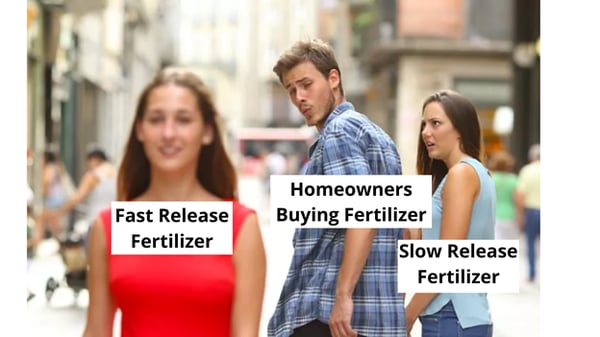
However, not one size fits all, while slow release is usually the better option. Fast release has some benefits and sometimes may be the better option. Before deciding on which fertilizer, do some research and don’t just choose the lowest price option. If you still have questions, call us to get our input, download a free guide, if we helped guide you to choose a good fertilizer that means we did something valuable that made a difference for you.
Fertilizer Spreader Options
Just like fertilizer, there are many different options for fertilizer spreaders. There comes down to 4 main ways of applying fertilizer:
1. Broadcast Spreader
This is by far the most common option; it is used to spread granular fertilizer across the lawn in an even distribution.
Pros of a broadcast spreader:
- Can cover a lawn in less time then other options
- Even distribution of fertilizer
- Capacity of up to 80lbs of product
- Side shield to avoid spreading in unwanted areas
- Very user friendly
Cons of a broadcast spreader:
- Leftover fertilizer is hard to empty out
- Can get fertilizer into garden beds, concrete, sidewalks easily
- A good broadcast spreader is expensive and typically over $500
- Less accuracy and uneven product distribution for inexperienced homeowners
A great article by Suave Yards mentions that a broadcast spreader is best for small to medium sized yards, which is typically what we see in Calgary. They also mention the top 7 spreaders available on the market.
2. Handheld Spreader
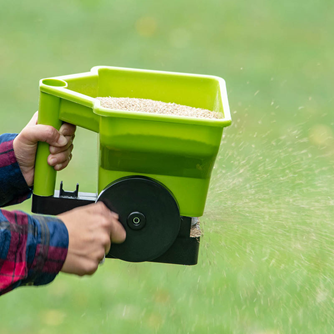
These are the tiny spreaders that can usually hold between 5-10lbs of product in them. They are for lawns where you cannot fit the broadcast spreader in, small lawns and garden beds.
Pros of the handheld spreader:
- Very affordable product
- Very good accuracy
- Very user friendly
Cons of the handheld spreader:
- Takes a while to cover a lawn over 1000 square feet
- Need to constantly refill spreader
- Tough to calibrate
3. Drop Spreader
These are typically more common for snow removal, especially on sidewalks since snow salt usually burns the lawn if its put into a broadcast spreader. However, they can be used in lawn care, they are very accurate and maintain in even spread.

Pros of a drop spreader:
- Very high accuracy
- Even spread distribution
- No product waste
- Very user friendly
- Good for winter use for ice melt
Cons of a drop spreader:
- Very expensive
- Takes a long time to cover a lawn
4. Liquid Fertilizer Application
Liquid fertilizer is typically granular fertilizer that’s been melted down and then put into the sprayer tank. You will get the exact same results with granular, assuming you water it in afterwards. The process is tedious, but there are lots of pros of using liquid fertilizer.
Pros of liquid fertilizer:
- Very high accuracy – you can easily see where you have/have not sprayed
- Can mix with herbicides and other beneficial products
- No product waste
- Even application throughout
- No need to water after application
Cons of liquid fertilizer:
- Tough to setup and calibrate
- Mixing needs to be accurate
- Very expensive setup











